History
A Brief History of The San Francisco Yacht Club
San Francisco Yacht Club, founded in 1869 and incorporated in 1873, is the oldest yacht club on the Pacific Coast. The original anchorage and Clubhouse were located on Long Bridge in San Francisco near Mission Rock. However, the filling of Mission Bay for the Railroad Transportation Center forced the Club to move.
Waterfront property was purchased in Sausalito and a new Clubhouse erected and opened in September 1878. The Clubhouse was destroyed by fire in 1897 with the loss of most of the trophies and records. Another Clubhouse was built on the same site in time for Opening Day 1898. This building is still standing and now houses the Trident Restaurant. Increasing auto ferry traffic and congestion in the early 1920s made another move imperative.
In 1926, a committee headed by Commodore Clifford Smith recommended that The Club buy the Belvedere Hotel property and the adjacent tidelands which they thought would serve as an ideal location. The purchase was made, and in 1927 the SFYC rented the Pacific Motorboat Club, dredged the Cove to assure a deep-water anchorage, and moved most of its operation to Belvedere from Sausalito.
Slowed by the Depression, a new clubhouse was finally built and opened in 1934 in time for the Opening Day celebration.
In early 1956, a basic harbor plan acceptable to the City of Belvedere and to The Club was approved. Construction was completed and the harbor was opened in late 1957. Originally there were 134 berths in the harbor. By 1960, additional berths were added to bring that number to 175.
A second building at 100 Beach Road was purchased in 1984 from the Dr. Clyde S. Payne family where four generations of that family had lived from 1916 to 1982. After extensive improvements, it was opened for Club use as an auxiliary venue for Club functions and private events and named the Cove House.
In 2018, the Cove House was razed and rebuilt as a much larger, modern building. The new Cove House was opened in 2020.
The San Francisco Yacht Club, with its tranquil setting on Belvedere Cove and its superb harbor, is widely recognized as one of the premier yachting facilities on the West Coast.
SFYC: A Historic Timeline
Take a tour through our history below.

In the summer of 1869, a group of active local yachtsmen formed the San Francisco Yacht Club – the first yacht club west of the Mississippi – to create a more orderly and monitored form of conduct, and ensure that Bay Area racing was respected elsewhere. The Bylaws and rules closely followed The New York Yacht Club. While the earliest of The SFYC's historical records were destroyed in a fire, it's believe that Richard L. Ogden, John L. Eckley, Captain Edwin Moody, Dr. J.C. Tucker and H.B. Platt were in attendance.

The original clubhouse was built at Long Bridge, close to where most of the members' vessels were moored at Mission Bay. By October 1869, membership numbered 115.

Start of the 1870 regatta. Emerald at the extreme left, and the steam yacht Amelia – owned by The SFYC's first Commodore, H.B. Platt – in the foreground

Emerald, winner of the first two SFYC regattas, off Mission Rock. The 42-foot sloop was built and owned by a founding member, John L. Eckley.


After the sale of the original clubhouse to the Central Pacific Railroad, the fleet likely moved to Front Street Wharf at Clark Point, in the lee of Telegraph Hill. Without a clubhouse, the Club became somewhat disorganized for a few years, until the Centennial Regatta (pictured here) sparked renewed interest. Twenty-nine boats competed on July 4, 1876; and 20 new members joined that year. Among those new members were men who'd led yachting on the Bay for decades, such as: C.R. Chittenden, Isidor Gutte, Stewart Menzies, William Letts Oliver, Matthew Turner and Charles G. Yale.

"Signing Articles, or Observations" was William Oliver's title for this picture of himself, Gutte, Yale and others on Chispa, a boat built by the prolific Bay Area shipwright and SFYC member, Matthew Turner.

With the Centennial Regatta launching a new period of racing, cruising and social events, The SFYC needed to build a new clubhouse (pictured here). The choice of the site near the ferry landing in New Saucelito (as it was called then) caused the first of two major splits in membership. Those who defected to the Pacific Yacht Club in Old Saucelito were members more willing to let professional crews work their yachts. Those who remained with The SFYC were mainly sailors who manned their own boats. That strong sense of individualism remains a characteristic of The SFYC today.

What the well-dressed yachtsman wore in the 1880s. William Letts Oliver showing approved technique at the helm.

Trimming the main without winches was a backbreaking job in those days.

In 1881, Charles Yale – long-time champion of small-boat racing – launched the first "Mosquito Regatta." The race was a great success, with 33 boats in four starts competing. Winners included Thetis, Bessie, Fleetwing and Dreadnought. The "prime potato" prize for slowest time was awarded to the misnamed sloop, Lively. Yale is pictured here in his favorite Mosquito boat, Yale's Yawl.

Chispa, one of Matthew Turner's famous schooners, successfully challenged and beat Annie in the Club's annual regatta in 1880. Chispa was also the scene of many festive and elaborate Club excursions.
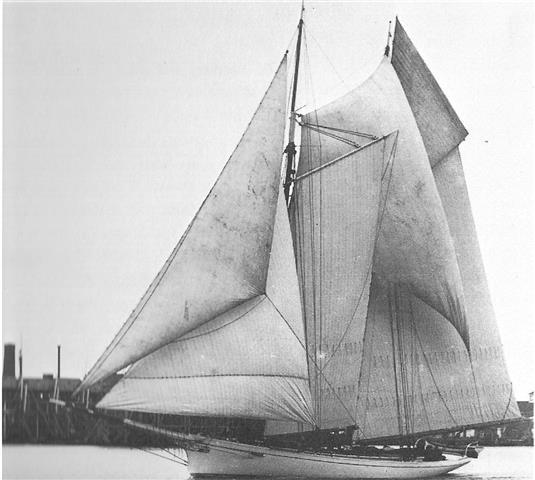
Aggie off Mare Island Shipyard. This classic schooner of the 1880s was built by W.G. Hall
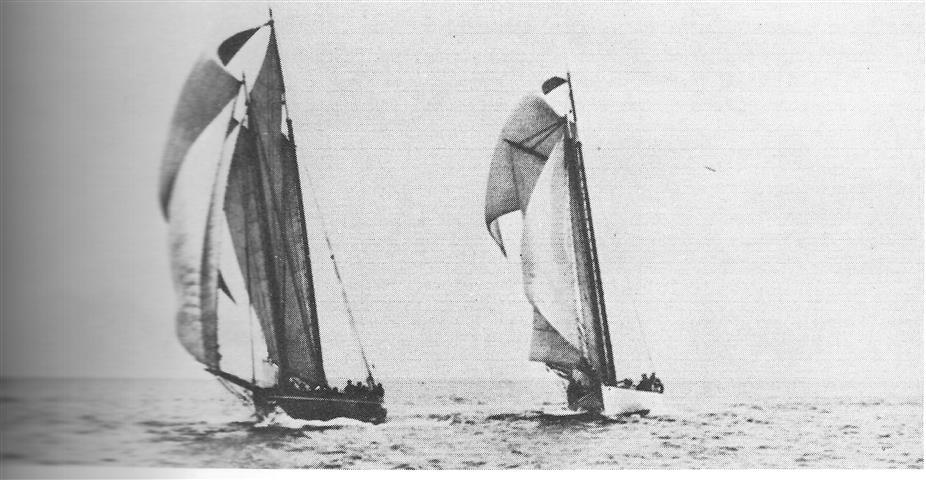
The SFYC's second decade opened with a rising tide of vendettas, in the form of match racing between larger craft. Pictured: A match race between Nellie and Fleur de Lys with $1,000 riding on the outcome. Nellie won.

A reunion of former SFYC officers in 1895. Five-time Commodore I. Gutte at the far right.

SFYC's second Sausalito clubhouse, after a fire burned the first location, with most of The Club's historical records, to its pilings in 1897.


Whirlwind, the boat of 1,000 rigs, was the fastest SFYC boat in the 1890s and swept all four regattas in 1894.

In 1895, a dozen SFYC members were part of a group of yachtsmen who subscribed to and organized the San Francisco Perpetual Challenge Trophy – open to challenge yearly from any yacht club on the west coast with more than three boats subscribed. In 1899, The SFYC captured the Cup aboard Matthew Turner's sloop Gadder, defeating the Corinthian YC Commodore's Truant (pictured here).

Club activities weren't limited to racing. Cruises were frequent and popular, with favorite destinations such as Vallejo, Antioch, Napa (pictured here) and Sacramento.

The Perpetual Challenge race of 1902. Although trailing Harpoon in this photo, The SFYC's Challenger went on to win.

While national interest in yachting waned at the start of the new century, local interest in off-shore racing took hold. The first Transpac was held in 1906 – with the infamous earthquake forcing the intended start of San Francisco Bay to be moved to Southern California. The 80-foot schooner Lurline (pictured here), built by Matthew Turner and originally owned by Spreckels, won the first Transpac after Spreckels sold her. In 1907, SFYC Commodore Francis G. Phillips donated the cup that launched the first of the Farallones races, followed quickly by the donation the Shreve Cup that launched the Lightship races in 1908.

Edris, Commodore Barneson's flagship, was a consistent winner in the 1900s.

Ripple was a constant threat in her class during the first decade of the new century.

Challenger winner of the 1092 SF Perpetual Challenge Cup



In 1915, the Panama Pacific International Exposition featured three weeks of yacht racing. More than 50 trophies were awarded, the most remarkable of which were put up by King George V and President Woodrow Wilson. The King George V Cup was won by SFYC Staff Commodore John Hanify, sailing Westward (pictured here).

Belvedere Lagoon (pictured below) was a popular summer spot for houseboats or "arks," and the Cove served as a winter anchorage for many yachts.

Yachting at the turn of the century brought out romance…even if Mama was along.

In the roaring 20s, The Club, which had previously been a male retreat and domain, began evolving to an organization of families. Bill Baird, a former bos'n on a British man-o-war and The SFYC's dock and Club caretaker, informally launched the SFYC's first youth sailing program in 1921. That first class of The SFYC's future yachtsmen pictured here.

Machree, sailed by J.R. Hannity, was winner of the Perpetual Challenge Cup in 1921, defeating the Corinthian YC sloop, Bob.

In 1923, L.A. Norris won both the Trans-pac and a return race to San Francisco aboard Mariner. Then, in 1925, won the San Francisco to Tahiti race.

In 1926, Don Lee repeated Norris' feat of winning both the Trans-pac and the race back to San Francisco aboard Invader.

In 1926, an increase in ferry traffic (which rolled the entire anchored fleet every 20 minutes in morning and evening rush hour), combined with a lack of parking for the growing number of cars, prompted the formation of a committee by Commodore Clifford Smith to search for a new location. Proposals were narrowed down to Belvedere Cove and a piece of land at the San Francisco yacht harbor that was built for the Exposition of 1915. After heated debate, the majority of members voted for the Belvedere site. Forty-nine members favoring the Marina site resigned en bloc and founded the St. Francis YC.

The clubhouse of the Pacific Motor Boat Club (pictured here) served as The SFYC until the new clubhouse was finished in 1934. In the wake of the Great Depression, times were hard, and members (including kids) built the new clubhouse themselves, led by Commodore Clifford Smith.

In 1932, Commodore Clifford established a perpetual cup for the Star fleet. It was won by Glenn Waterhouse and Woodbridge Metcalf aboard Waterhouse's Three Star, Too – the first Star on the Bay to carry the Bermuda rig. (Commodore Smith had brought the Star fleet to the SF Bay in 1923 – the same year a group of members were instrumental in the syndicate that built the pilot boat of the Bird fleet.) Three Star, Too, flying the SFYC burgee, went on to win the 1933 Star World Championship.


By the mid 1930s, the number of power boats on the official SFYC rolls surpassed the number of sailing vessels.

The mid ‘30s also marked the last chapter for one of the fleet's most venerable and valiant craft, the 74-year-old Annie. She'd been raced hard and cruised for thousands of miles on the Bay. She was given a Viking funeral by long-time owner Dr. Emmet Rixford in 1935. All but her mast was burned at Hunter's Point as a solemn crowd watched. The mast was taken ashore and stepped as the Club's flag mast – a function it served until 1961, when dry rot forced it to be replaced by a replica.

Bird Boats in the 40s – going strong its third decade as a class.

Frank "Jake" Wosser, stationed here in Naval Intelligence during WWII, won the Star class Joe Harris Perpetual Trophy in 1942, 1943, 1944 and in 1948, when the trophy recommenced after a brief post-war hiatus. He also won the Star class championships in 1944 and 1945. Picture here, Star class beating upwind.

Go slow, Jake! This sign could have been posted by any one of Commodore Wosser's competitors. In 1948, Wosser swept the 13 events of the Bay Star Series in Can Can, the Star he built himself (pictured here).

Dream losing the Perpetual Challenge to Hanahuli of the Los Angeles YC in 1949.

Belvedere anchorage before harbor and breakwater.

The member roster doubled and 31 boats were added to the fleet in 1941, when The SFYC agreed to incorporate the 150 members of the Richardson Bay Yacht Club – whose previous clubhouse was the Barkentine, Echo, pictured here.
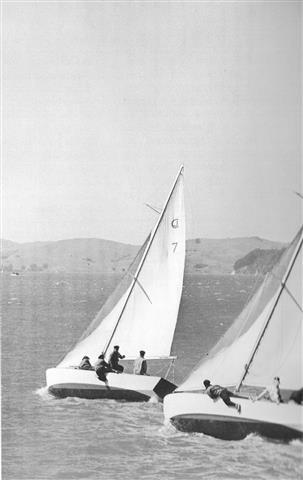
Junior Clippers were a popular class through the 40s.

To address the anchorage problem plans had been drawn up back in the 30s to dredge the cove and build a bulkhead to block storm surge, but plans were abandoned in the wake of the Depression and WWII. Finally, in 1955, Commodore Leonard G. James appointed and headed a Harbor Committee. To finance the creation of the Harbor, they issued promissory notes of $50 face value that carried five percent rate of interest. Club members purchasing the notes in lots of 25, 35 or 45 notes would be granted berthing rights in slips. Monthly slip fees would cover ongoing maintenance and interest fees on the 15-year notes. Work began in 1956 and 175 berths were completed over several years.

In 1959, The Club won the Admiral Chester Nimitz Trophy for its youth training program.

After two unsuccessful SFYC challenges for the Perpetual Cup earlier in the decade, in 1959 Commodore Wosser, on the IOD Rutsan defeated Sausalito YC's defender Norena.

Club remodel and expansion

South hoist before the harbor was built.

Original dry storage and boat that took members to their moorings.

In 1965, Jake Wosser won the IOD World Championship held on San Francisco Bay, and repeated that feat the following year in Bermuda.

The decade marked the strengthening of The Club's youth program. Thom Martin introduced some new ideas in 1964, then Hilly Stong took over in 1966 to broaden and expand the program. The program changed from a weekend affair into five highly organized days per week. The Nimitz Trophy earned in 1966 and 1969 are a testament to the growing success of the junior program. Hilly's class of 1969 pictured here.

Capping off an eventful decade, Mike Shea's Lively Lady II, designed by Gary Mull, regained the Perpetual Cup after a successful SORC campaign.

Knarr Class beating to weather off the Presidio in the first International Knarr Championship held in the Bay (1969). Bob York of The SFYC won.

On the IOR boat Imp, Dave Allen campaigned the SORC again in 1977, returning with overall honors. Then again, onto the Admiral's Cup where Imp beat out 300 boats in the Fastnet race.

In 1972, the Perpetual Cup challenge came from San Diego YC with their Palmer Johnson Allegre. Team Wosser and Damner trounced them in Sunchaser of the same class.

A successful defense was raced in 1973 when SFYC's Gamma edged out San Diego YC's Crisis.

In 1974, San Diego challenged again the following year in Kingfish, but couldn't break our hold on the trophy against Wosser in Bohemia, a Carter 39 owned by Peter Salz.

The SFYC chalked up its sixth successful defense of the Perpetual Cup in 1975. Wosser, racing aboard the Bird Boat Oriole won against Corinthian YC's Skylark. The following year San Diego broke the spell in 1976, with Cadenza defeating Racy.

In 1976, Jake Wosser reclaimed the San Francisco Challenge Cup from the St. Francis YC aboard Bohemia.

Dave Allen built Improbable, which he sailed to win the 1971 SORC Montego Race. T
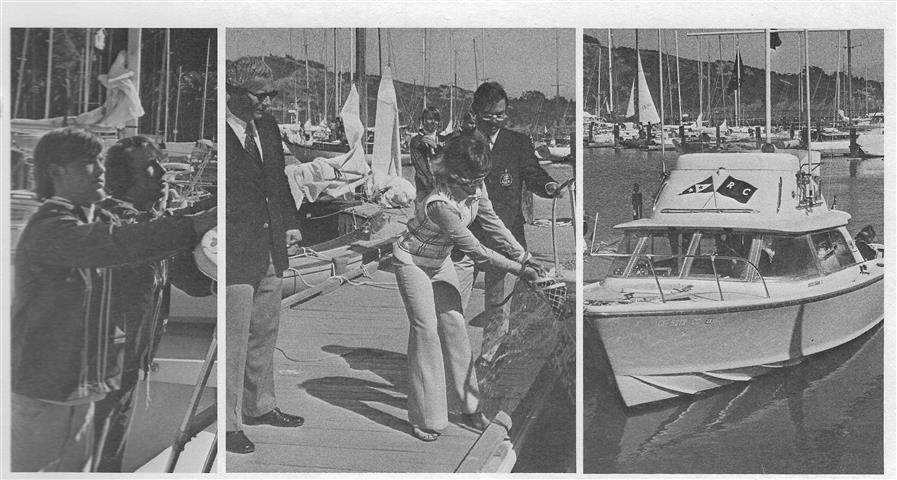
Juniors Vann Wilson and Alan Norman hoist the flags, and Tom Carnes and Derk Te Roller assist Mrs. Jerry Leth at the christening of the original committee boat Victory in 1974.
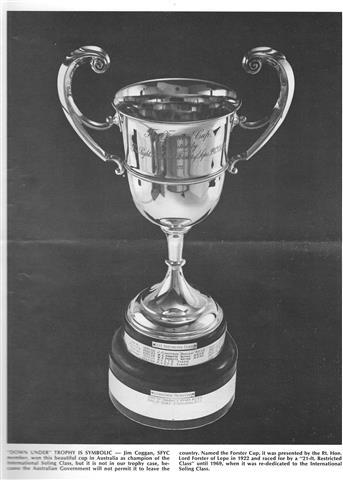




Bylaws amendments open up Regular membership to women in 1976



Drought nothing new to Cailfornia, as we can see from this Bulletin article from 1977.


Our timeline is under construction. We encourage members to submit racing, cruising and Club pictures and captions of milestones for consideration to [email protected].

Our timeline is under construction. We encourage members to submit racing, cruising and Club pictures and captions of milestones for consideration to [email protected].

Our timeline is under construction. We encourage members to submit racing, cruising and Club pictures and captions of milestones for consideration to [email protected].

Our timeline is under construction. We encourage members to submit racing, cruising and Club pictures and captions of milestones for consideration to [email protected].

Our timeline is under construction. We encourage members to submit racing, cruising and Club pictures and captions of milestones for consideration to [email protected].

Our timeline is under construction. We encourage members to submit racing, cruising and Club pictures and captions of milestones for consideration to [email protected].

Find out if that's an SF Cup picture on the cover shot

Major harbor project gets underway in 1983 – two new boom hoists and an improved deck to better handle SFYC and visiting yachts.


Junior Sailing Fund, established by Don Harvey and Tad Lacey in 1981, helps SYFC junior sailors compete at the national and international levels.




In the summer of 1984 escrow closed on the Keaton property (now the Cove House) and a use permit was obtained by the City of Belvedere. Photo of member volunteers, hard at work.

The Cove House was dedicated in 1985.


1988, Cove House under renovation.
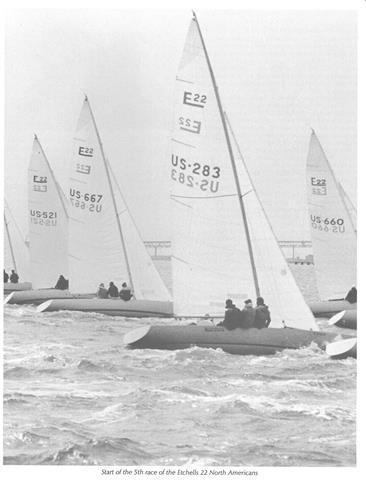
Jeff Madrigali, Hank Easom and Don Jesberg take 3rd, 4th and 6th (respectively) in '86 Etchells North American Championship.


Will Baylis wins silver as Soling crew at the 1988 Olympics in Pusan, Korea.

Hank Easom's Yucca, photographed in 1986, has proven to be a formidable competitor on the Bay for more than three decades.
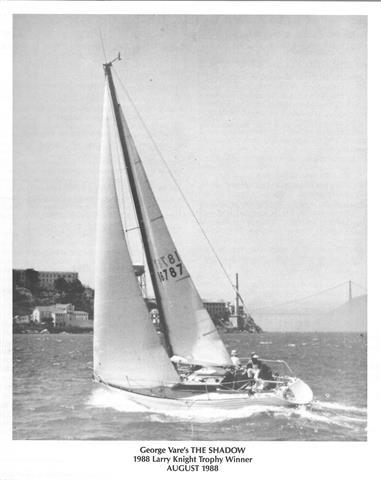

Our timeline is under construction. We encourage members to submit racing, cruising and Club pictures and captions of milestones for consideration to [email protected].

Our timeline is under construction. We encourage members to submit racing, cruising and Club pictures and captions of milestones for consideration to [email protected].

Our timeline is under construction. We encourage members to submit racing, cruising and Club pictures and captions of milestones for consideration to [email protected].

Our timeline is under construction. We encourage members to submit racing, cruising and Club pictures and captions of milestones for consideration to [email protected].

Our timeline is under construction. We encourage members to submit racing, cruising and Club pictures and captions of milestones for consideration to [email protected].

Our timeline is under construction. We encourage members to submit racing, cruising and Club pictures and captions of milestones for consideration to [email protected].


